Verroccio Telling Leonardo to Never Paint Again
His proper noun was Verrocchio (sounds like Pinocchio). That's the short answer to our title question. Andrea del Verrocchio (1435-1488) was a Florentine primary of arts and the tutor to the young Leonardo da Vinci.
The longer clarification of Verrocchio is quite engaging. He was a man who had an enormous influence on the world and inverse it for the better, something that cannot be said of all Renaissance figures. Like many Italian greats, however, he is known to history simply by his last name.
Cultural context
If you lot had lived in Florence in the mid- to late-1400s you would take heard the name of Verrocchio in everyday chat. He was the personal painter and sculptor to the famous Renaissance rulers Piero and Lorenzo de' Medici, a position he assumed in 1466 afterward the other cracking Medici favorite, Donatello, had passed away.
The reason y'all may never have heard of Verrocchio is because of the shining star that emerged from his Florentine studio. Leonardo was like the sun that eclipses the light of the moon when it rises.
There is a famous story (probably apocryphal) which is relevant to the image we volition examine below. When Verrocchio assigned his educatee from the little Tuscan 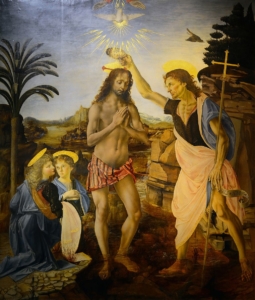 village of Vinci to paint an affections on Verrocchio'south larger sheet of The Baptism of Christ, it is said that the pupil's affections so surpassed the master'due south in skill and artistic grace that the erstwhile man vowed never to pigment once again. We tin can hear shades of John the Baptist himself in reference to the advent of the Messiah: "He must increment while I must subtract" (John 3:30).
village of Vinci to paint an affections on Verrocchio'south larger sheet of The Baptism of Christ, it is said that the pupil's affections so surpassed the master'due south in skill and artistic grace that the erstwhile man vowed never to pigment once again. We tin can hear shades of John the Baptist himself in reference to the advent of the Messiah: "He must increment while I must subtract" (John 3:30).
That'southward the pious legend anyway. It's more than likely that Verrocchio simply changed his focus to sculpting at that betoken in his career!
An astonishing human
At that place is a sure humility and quality of character almost Verrocchio that one finds when reading his story. Rather than use his own name, which was Andrea di Michele di Francesco de' Cioni, he preferred to be known professionally by the name of his own mentor, a Florentine goldsmith past the name of Giuliano Verrocchio.
The symbolism of this name is non lost on lovers of Italian art and language: Verrocchio means "truthful center".
Verrocchio never married simply defended himself to producing his art and mentoring future artists. His cede of wedlock and family left the globe with one of the greatest teaching legacies known to history considering Verrocchio remained free his entire developed life to ply and laissez passer on his merchandise. On that thing, Leonardo da Vinci, while his most historic pupil, was non his merely height performing student.
The listing of famous painters apprenticed in Verrocchio's studio reads like a Renaissance Hall of Fame: Leonardo da Vinci (1452-1519), Sandro Botticelli (1445-1510), Pietro Perugino (1450-1523), Lorenzo di Credi (1459-1537), Domenico Ghirlandaio (1449-1494), and the Sienese painter, Francesco di Giorgio (1439-1502), likewise as prominent Florentine sculptors Benedetto da Maiano (1442-1497) and Andrea Sansovino (1467-1529).
It is hard to imagine such a gathering of talent in 1 place and time in history!
The reason I'1000 not overstating things when I say that Verrocchio changed the earth is because his students ushered in the High Renaissance, and many of them ready their own studios and taught students what they learned from their chief.
The ripple effect from simply two of these famous artists is astonishing: Perugino was the mentor of Raphael and Ghirlandaio tutored Michelangelo!
In what I've read of Verrochio's life, at that place seems to exist no scandal, no temperamental fits, and no immoral lifestyles and then often associated with artistic types. He lived out his years in the home of his sister helping to care for her large family unit and was generous to a fault in coming together their needs. When he died at the young historic period of 53, he left his precious studio to Lorenzo di Credi, who built upon the accomplishments of his principal.
Productive years
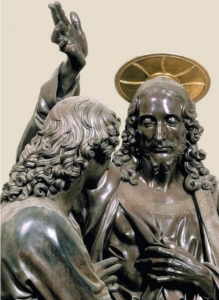 Verrocchio'southward productive years were generally confined to the ii decades from the late 1460s until his death in 1488. As a sculptor, his two about famous statues are a young David and the incredible Doubting Thomas sculpture (left insert), both of wh
Verrocchio'southward productive years were generally confined to the ii decades from the late 1460s until his death in 1488. As a sculptor, his two about famous statues are a young David and the incredible Doubting Thomas sculpture (left insert), both of wh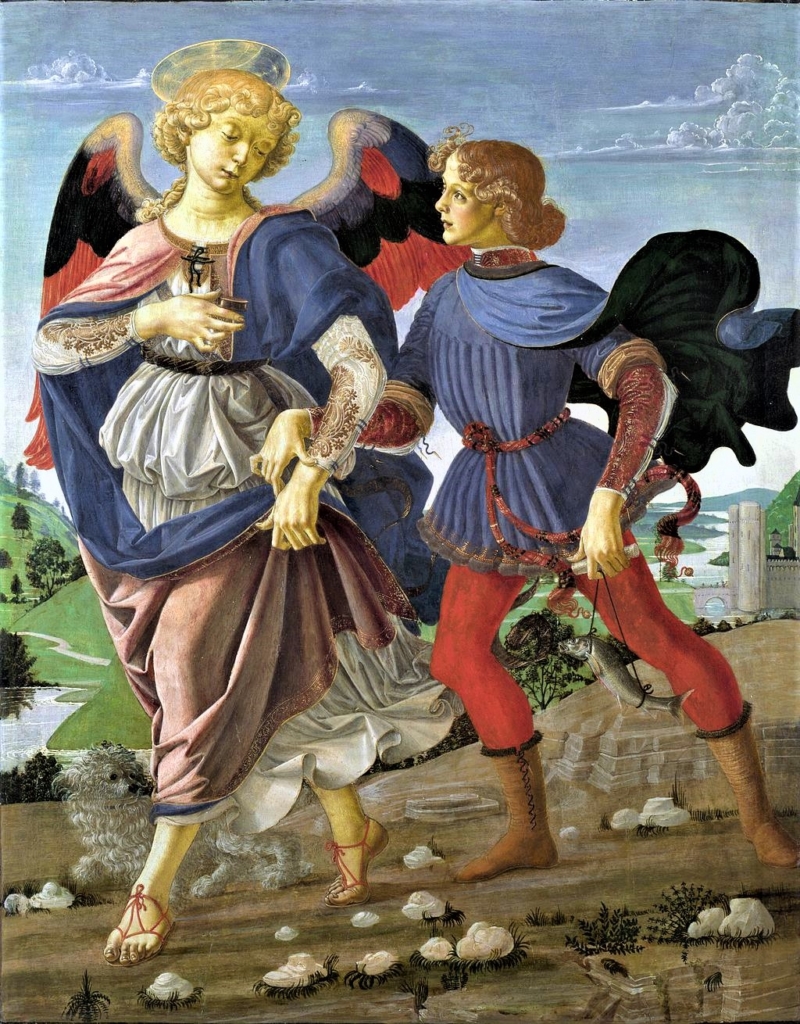 ich were displayed by the National Gallery in Washington DC in a 2019 exhibition.
ich were displayed by the National Gallery in Washington DC in a 2019 exhibition.
Of his paintings, the almost famous is probably Raphael and the Young Tobias (right insert), which offers a delightful snapshot of the Archangel in his human being disguise walking and talking with Tobias on their journey to Media (recounted in Tobit six and 10). It is a classic Renaissance work, echoes of which we find later in many of Botticelli's paintings.
The Baptism of Christ
Nosotros mentioned in a higher place that the young Leonardo painted an angel on the canvas of Verrocchio's other famous piece of work, The Baptism of Christ (1470-1474). The noteworthy angel is one of two that grace the lower left-hand corner of the painting. The angels are witnesses to the awesome upshot: i was painted by Verrocchio (or possibly another student) and the other by Leonardo.
Before I tell you which is which, look closely at a item of the two angels and come across if you lot can figure out the corresponding artists. (Hint: pay shut attention to the hair, garments and facial features of the angels.)
First clue: farthermost delicacy
It should become clear that the angel on the left, gazing admiringly up at his Lord receiving baptism, is Leonardo's. This affections looks, we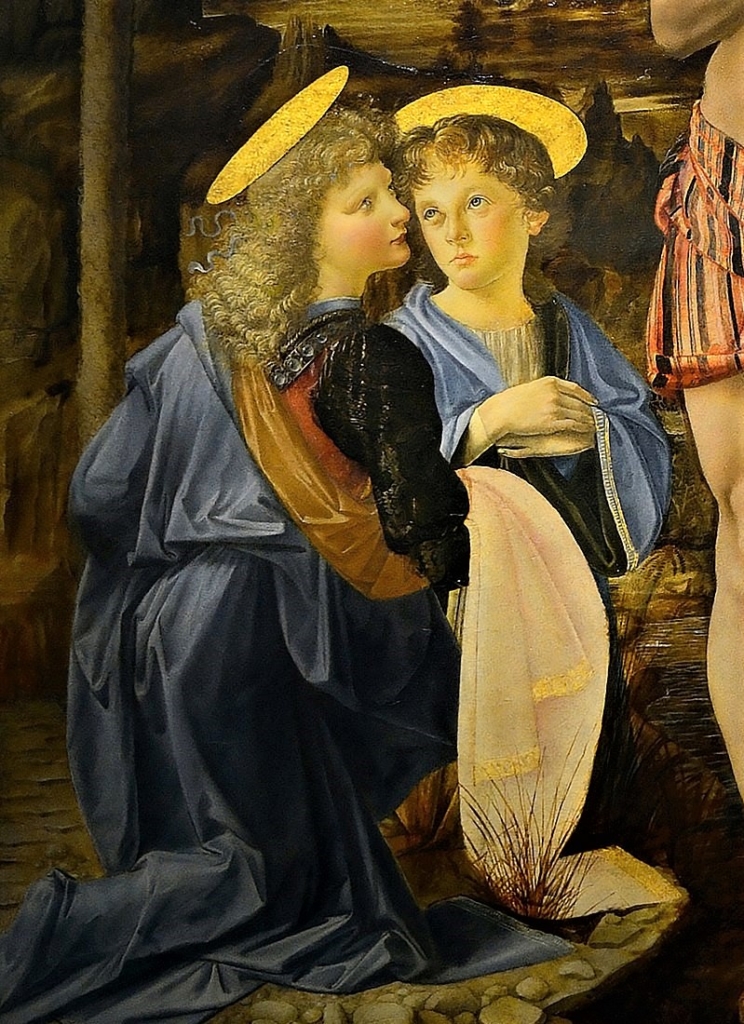 ll, angelic!
ll, angelic!
He has extremely fine and detailed hair, eyes and facial features as well as crisp and clearly-divers fold lines in the article of clothing. He is dressed in at least iv different colored garments while property what looks like a baptismal robe of a fifth color. The garments contain subtle shading that combines with color and line to make this tiny visitor from heaven into a shimmering vision of grace and loveliness.
In contrast, Verrocchio'southward angel is somewhat homely with matted hair and i heart larger than the other. He looks rather similar a little male child dressed for a school play. There is very little to admire about this plain tunic of a single hue with very little shading. This affections'south confront and easily have less clarity of item, less crispness of line and radiance. It is overall a rather unimpressive figure.
Second clue: position
Consider also the positioning of Leonardo's affections. If you lot were to try to strike a pose like that you lot would need a chiropractor!
It is owing to his precocious skill that the young Leonardo could depict the angel kneeling in i direction, while at the same time turning his face sideward and upwardly with an otherworldly glance toward the two standing figures. Only a great master could brand the positioning look entirely natural, or supernatural, as the instance may be.
Third clue: halo
We as well become a unique side view of a golden halo on this affections that foreshadows changes to come in afterward Renaissance religious fine art. Prior to this menstruation, artists largely portrayed the holiness of saints and angels with large, round, flat halos encompassing their heads, similar to what we come across on Verrocchio's angel (as also the larger halos on Christ and John the Baptist.) The angel's halo is opaque and without nuance.
Leonardo's halo breaks new basis. Because of the tilt of the affections's head, Leonardo has accurately skewed the halo to our view, making it a much finer and gentler symbol of sanctity, which seems to hover delicately above the flowing curls. Other artists like Botticelli, and afterwards Raphael, taking their cue from Leonardo, will remove the solid gold halo altogether and depict it as a delicate line or trace of low-cal around the holy figure's caput. Leonardo paved the way for this remarkably subtle advancement in the religious art of his era.
If Verrocchio, upon seeing Leonardo's angel, actually did throw his hands upward and declaim, "I shall never paint again!" he would have had good reason. The coming solar eclipse past his brilliant student was on the horizon.
However, if this master of the great masters was the kind of authoritative teacher information technology seems he was, information technology is more than likely that he gazed in admiration at his educatee's work and encouraged him to paint more!
As I said, Verrocchio changed the globe.
Soul Work
Call back of all the teachers you lot have had in your life. Few of us will be apprenticed to great and globe-renowned masters of their fields, but all of the states will wait dorsum over the course of our lives, upwardly to and including the nowadays moment, and recognize those generous souls who accept contributed to our learning and development.
We must not see human being development only in terms of skill improvement either. People who give us tangible examples of virtue are our moral mentors. They inspire united states of america only equally clear-minded leaders give us courage to detect our paths and knowledgeable artisans of our trades influence us positively at every bespeak forth the way.
Identify two or iii of your most beloved teachers and give thanks God for the blessings they brought (or even so bring) into your life. While you are at it, also take a moment to acknowledge those people by whose negative example you have learned something. People similar that usually need the generous prayers of their forgiving students.
Ane Comment
Verroccio Telling Leonardo to Never Paint Again
Source: https://sacredwindows.com/who-taught-leonardo-to-paint/
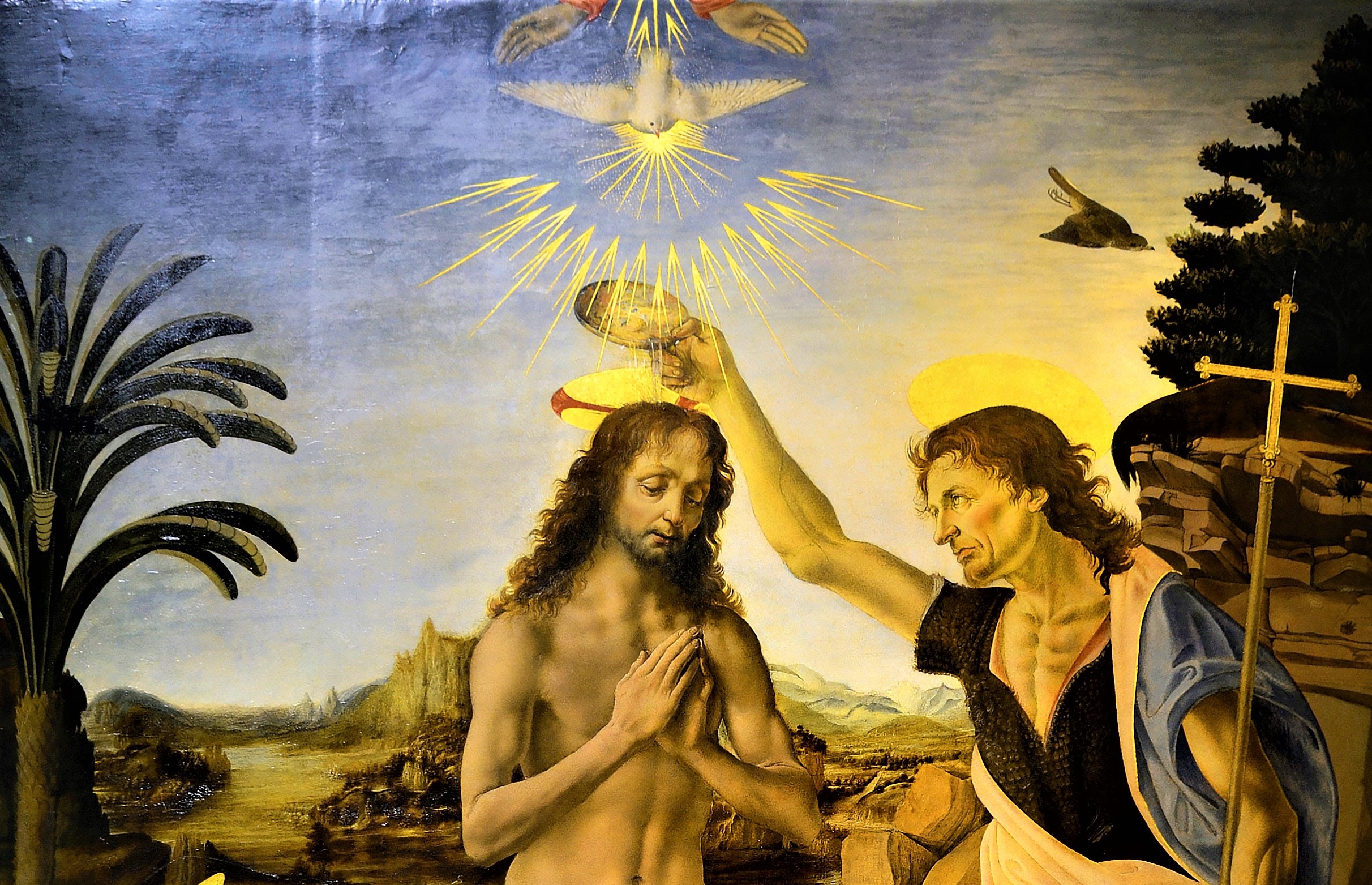
[…] Gabriel's halo, Mary'south is pure gold, symbolizing her purity and holiness. As I mentioned elsewhere, the early Renaissance commonly featured opaque, gilded halos equally a holdover from earlier icon […]